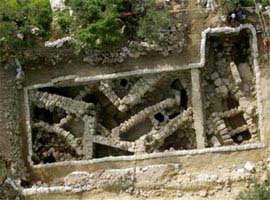Ancient Underground Tunnels Used by Jews During Revolt Against Romans Discovered in Northern Israel
 |
| Aerial view of the Jewish secret tunnels. (Photo: AP) |
The Jews stored goods in interconnected underground chambers in preparation for their uprising from 66 to 70 AD.
Yardenna Alexandre from the Israel Antiquities Authority stated that this discovery demonstrates that the ancient Jews had planned and prepared for the revolt, countering the common belief that it was a spontaneous act.
The underground chambers in the village of Kfar Kana, north of Nazareth, were built using common household materials and were buried just beneath the floors of their homes, allowing families to escape quickly. “These structures were cleverly disguised. Under one house, there are three chambers and a tunnel leading to another house’s chamber. This chamber contained 11 jars,” Alexandre explained.
Similar to snow caves, these chambers are wide at the base and narrow at the top. The passageways are short, and the ceilings are low, making it impossible to stand upright.
Zeev Weiss, a professor of archaeology at the Hebrew University in Jerusalem, noted that this discovery could provide valuable insights into life in Galilee during the 1st century and the preparations for the Jewish uprising.
The Jewish revolt against Roman rule concluded in 70 AD when the Romans defeated Jerusalem and destroyed the Second Temple.
The ancient Jews in Kfar built their homes on the ruins of an Iron Age city, reusing materials from old dwellings. They then dug deep into the ground to create shelters.
Remains of a settlement dating back to the 9th-10th century BC were also uncovered. Archaeologists found a large quantity of animal bones, jewelry depicting a man surrounded by two crocodiles, and a piece of pottery featuring a lion.
M.T.


















































